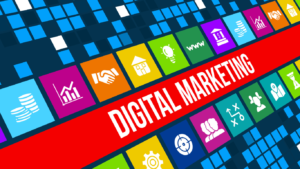
Ever wondered which marketing approach is right for you: Traditional Marketing or Digital Marketing? Welcome to Priya Pandit’s blog! I am here to help you understand these two popular strategies. From the familiar feel of print ads to the modern touch of online campaigns, we’ll look at the key differences, benefits, and real-life examples. Whether you’re a small business owner or just curious about marketing, understanding the difference between traditional marketing and digital marketing can help you make better choices for your business. So, let’s keep it simple and fun!
What is Traditional Marketing?

Traditional marketing is like the seasoned pro of the marketing world. Think of it as the trusted newspaper you used to read with your morning coffee or the catchy jingle from a TV commercial that’s stuck in your head. Here are some common types of traditional marketing:
- Print Ads: These are ads you see in newspapers and magazines. Picture the last time you flipped through a magazine while waiting at the dentist’s office.
- Broadcast: TV and radio commercials. Remember that catchy jingle from a TV ad that you can’t get out of your head?
- Direct Mail: newsletters and catalogs sent to your house. Like those holiday catalogs you get every year.
- Outdoor Advertising: Billboards and posters you see while driving around town.
What is Digital Marketing?

Now, let’s talk about digital marketing. This is all about using the internet to reach people. Imagine browsing Instagram and seeing an ad for those shoes you were looking at online. That’s digital marketing in action! There are different types of digital marketing:
- SEO (Search Engine Optimization): Get your website to show up higher in Google search results
- Content Marketing: Writing blog posts and articles (like this one!) to attract and keep readers.
- SMM (Social Media Marketing): Connecting and engaging with your audience using sites such as Facebook, Instagram, and Twitter.
- Email Marketing: Sending newsletters to subscribers who are interested in receiving updates and special offers.
- PPC (Pay-Per-Click Advertising): Ads you see on Google and other websites where you pay each time someone clicks on your ad.
Digital Marketing Vs. Traditional Marketing
Let’s explore the difference between traditional marketing and digital marketing to see which might work better for you.
1. Reach and Audience Targeting

Traditional Marketing:
- Broad Reach: Traditional marketing can reach a broad audience. Picture a TV commercial airing during a hit show.
- Geographic Limitation: More effective for local businesses. Like your local pizza place sending out flyers.
- Demographic Targeting: Can target broad groups like age and gender, but not very specific.
Digital Marketing:
- Global Reach: Your message can reach people all over the world. Perfect for online stores.
- Precise Targeting: You can target very specific groups. Like showing ads for hiking boots to people who love camping.
- Engagement Tracking: You can see how people interact with your ads and adjust quickly.
2. Cost and ROI

Traditional Marketing:
- High Costs: Ads on TV or in magazines can be expensive.
- Difficult ROI Tracking: It’s hard to know exactly how many people came to your store because of a billboard.
Digital Marketing:
- Cost-Effective: Running ads on social media or sending emails is usually cheaper.
- Measurable ROI: You can easily track how many people click on your ads and buy your product.
3. Interaction and Engagement

Traditional Marketing:
- One-Way Communication: You put out your message but don’t get instant feedback. Like a radio ad.
- Limited Engagement: Harder to interact directly with your audience.
Digital Marketing:
- Two-Way Communication: You can talk to your audience directly. Imagine responding to comments on your Facebook page.
- High Engagement: People can like, share, and comment on your posts, making them more interactive.
4. Flexibility and Adaptability

Traditional Marketing:
- Less Flexible: Once an ad is out there, it’s hard to change. Think about a printed magazine ad.
- Longer Lead Times: Creating and distributing traditional ads can take a lot of time.
Digital Marketing:
- Highly Flexible: You can change your ads quickly based on performance. It takes a few minutes to update any social media post.
- Quick Launch: Start a digital campaign almost instantly, perfect for reacting to trends.
5. Analytics and Data

Traditional Marketing:
- Limited Data: Hard to measure how effective your ad was. Did people notice your billboard and then come to your store?
- Guesswork: Often relies on estimates and surveys to gauge effectiveness.
Digital Marketing:
- Rich Analytics: Get detailed data on how your ads perform. You can see exactly how many clicks, views, and sales you receive.
- Data-Driven Decisions: Use real-time data to tweak and improve your campaigns.
Real-Life Examples
Let’s connect these ideas with real-life examples:
-
Traditional Marketing Example: Think about Coca-Cola’s holiday ads. They’re everywhere – on TV, on billboards, and in magazines. These advertisements reach a large audience and create a festive feeling.
-
Digital Marketing Example: Imagine a small bakery that uses Instagram to show daily specials. They post photos, engage with followers, and use hashtags to reach more people. This helps them attract more customers locally and beyond.
Benefits of Traditional Marketing
- Tangible Experience: Holding a magazine or seeing a billboard can be more memorable.
- Credibility: Ads in established media like TV and newspapers can build trust.
- Brand Awareness: Great for making your brand known in a local area.
Benefits of Digital Marketing
- Cost-Effective: More affordable for small businesses.
- Real-Time Results: See how your campaigns are doing right away.
- Targeted Reach: Contact the people you desire.
- High Engagement: Build stronger relationships with your audience.
Traditional Marketing Vs. Digital Marketing: Which One Should You Choose?
- Local Businesses: If you own a local cafe, combining local newspaper ads with a strong social media presence can be effective.
- Global Reach: For an e-commerce store, digital marketing is essential.
- Budget Constraints: Small businesses with tight budgets might find more value in digital marketing.
- Audience Demographics: Traditional methods might work better for older audiences, while younger people are more likely to be found online.
Conclusion
In the end, there’s no single answer to the digital vs traditional marketing debate. What works best for you will depend on your own needs and objectives. You can choose wisely for your company if you know how traditional and digital marketing differ from one another.
Thanks for stopping by! I hope you found this article helpful. Stay tuned to Priya Pandit’s blog for more easy-to-understand and useful marketing tips!


